Progress – From 1800 to Today
Q: How did the farmers in the mid 1800s manage to grow their crops successfully with no fungicides, no pesticides and no herbicides?
A: I’m not sure “successfully” is the right term to use. Much of their weed and insect control came from human or animal labor: hand-picking bugs and hoeing or plowing weeds. A few insecticides were used, mostly pyrethrum, arsenic, nicotine, etc. A couple of fungicides were known, many based on copper, sulfur or lime. Salt was utilized to kill weeds in some situations but obviously couldn’t be used in any quantity. Yields were poor and a huge proportion of the American population farmed so that others could live in cities. As the son of a farmer, I hand-picked hundreds of potato bugs and hoed acres of vegetables. The Cooperative Extension Service was formalized in the early 1900’s to educate farmers on better methods of farming and pest control. In 1945, it took 14 labor-hours to produce 100 bushels of corn on 2 acres of land. In 2002, that same 100 bushels of corn were produced on less than 1 acre. I call that amazing progress!
















